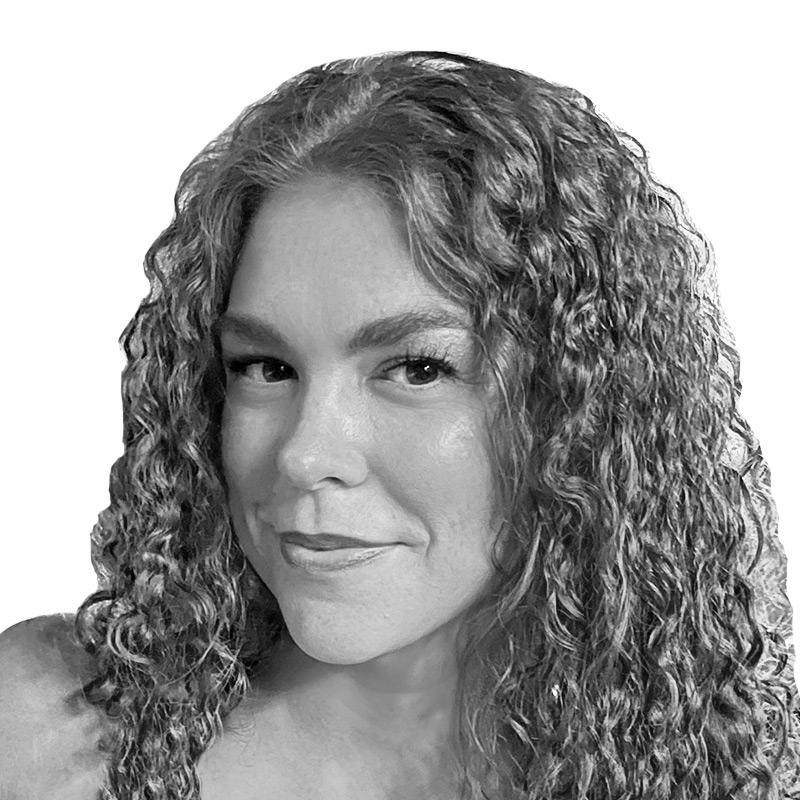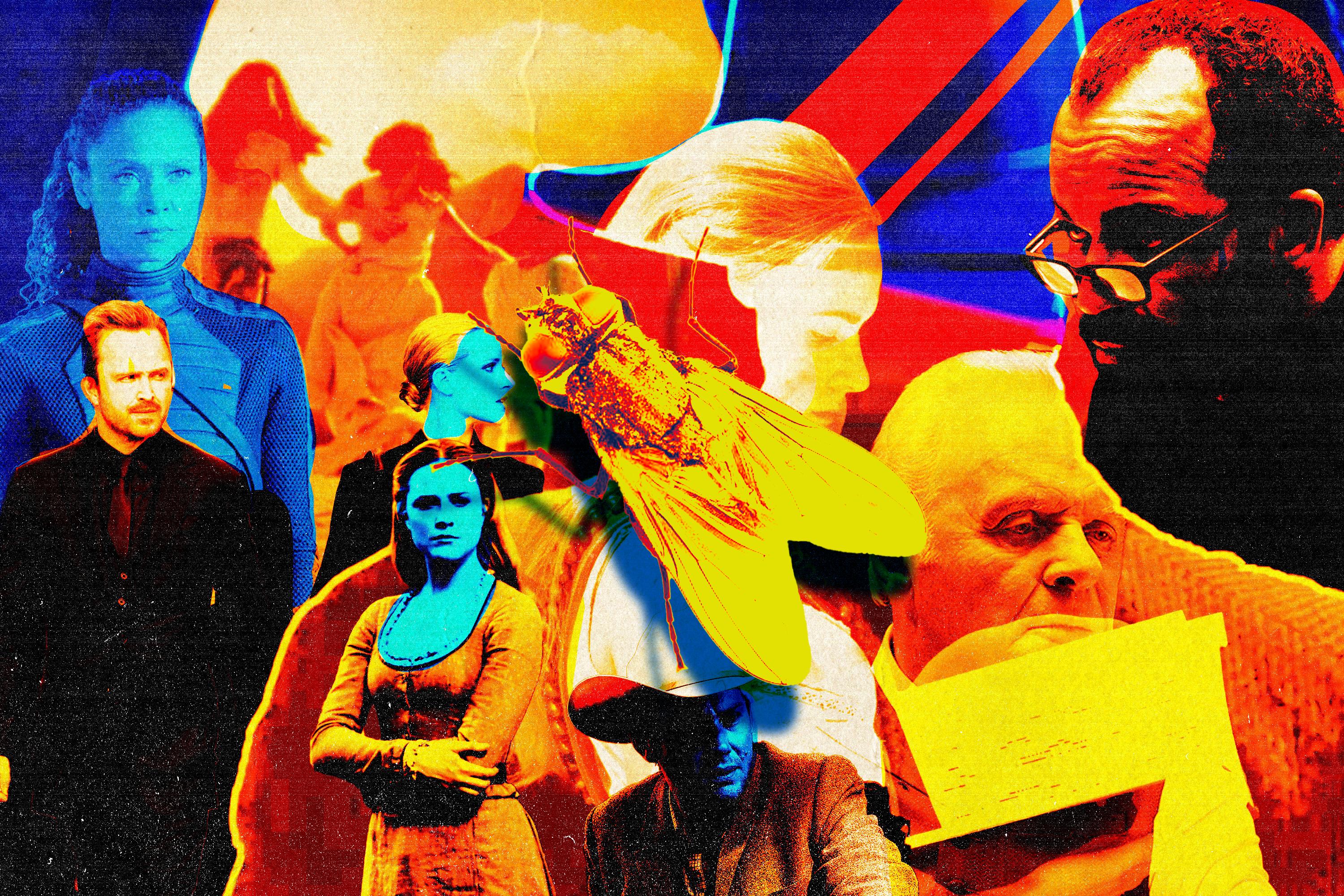
Have you ever questioned the nature of your reality? Have you ever watched Westworld? I have—specifically, I’ve rewatched the past three seasons in the past three days—and almost nothing makes me question the nature of my reality more than being wildly confused by a series that is, technically, about rich people going to Fancy Six Flags (and then getting hunted down by the robots at that Fancy Six Flags, and then having the killer robots follow them outside the Fancy Six Flags gates, and into the real world … but I digress). The way Westworld plays with time is, at moments, masterful, and at other moments downright rude. Between the nonlinear approach its creators have taken and the two-year gaps that tend to pass between new seasons, it’s incredibly easy to get mixed up about what happened, and when it happened. Trying to remember the plot points that could have possibly led to Evan Rachel Wood and Luke Hemsworth rhythmically fighting to The Weeknd’s “Wicked Games” (my main and lasting memory from Season 3) is enough to make you dramatically stretch your fingers out in front of you and—to quote a dear, robot-version-of-the-SkyScreamer friend of mine—ask, “What am I? When am I? Am I going mad?”
Of course, the intention of Westworld is kind of to drive us mad—mad with curiosity about what’s going on here, who’s a robot, and what happened to all the host-tigers from the Raj world in Season 2. Because Westworld is about more than just killer robots, as Westworld has been trying desperately to tell us for three seasons. It’s about the things that make us human: pain, time, loss, love, choice. It’s about wondering whether those things still make one human when they’re coded not into one’s brain, but rather into a shiny ball that sits inside an indestructible port where one’s brain should be.
Westworld’s broader themes include the always sexy trinity of Big Data, Intellectual Property, and the Unbridled Entitlement of a White Man Who Married Into a Family With Theme Park Money (shout-out to William, the proto–Tom Wambsgans). It’s a classic upstairs/downstairs story for the technology age. (And don’t forget about the sub-basement full of robots whose numbers could perhaps be described as … army-sized?) But we’re simply not here to dive deeper on the philosophy of the bicameral mind, or the deepest, darkest Reddit theories that may or may not still come true. Those are questions for scholars and saints. No, in advance of the Westworld Season 4 premiere on Sunday, we’re simply here to try to weed through the meaning of Westworld, to get to what actually happened in Westworld.
These violent delights have confusing ends, after all, and I know there are some people—most people, perhaps—who didn’t watch the past three seasons of Westworld in the past three days to jog the memories from their brain pearls. I know there are some people who watched the first season of Westworld in pure delight and then forgot the show existed at all. I know there are other people who have watched every single episode of Westworld and still feel their throat tighten up and their ears start ringing whenever they try to start remembering who’s alive, who’s dead, and who’s a robot whose consciousness exists only inside robot heaven. For you, and all the host bodies that your brain now lives on in, these are the most shocking things that have come to pass on our consciousness-altering journey toward Westworld Season 4.
Season 1: Oops, They’re Robots!
1. Everyone is clamoring to vacation in the Old West
Westworld, theme park of the future, was conceived by Robert Ford and Arnold Weber, two engineers who together created robots so lifelike they passed the Turing test. They called these robots “hosts,” and they came equipped with standard guidelines like the inability to harm humans or lie to their creators. And with this great achievement in science and engineering, this unprecedented advancement in technology … Ford and Arnold decided to open an Old West–themed amusement park? Yes, Westworld comes with the general theme and moral infrastructure of The Purge, but guests could have abused robots in almost any setting—why would Ford, Arnold, and their investors choose such an unglamorous one? During those first few years, all the rich people would put on their little vests and spurs just to get a peek at those androids, sure … but after that, who wants to vacation where you can’t even get an old-fashioned, just a lukewarm glug of sarsaparilla or whatever?
2. The robot uprising starts with an iOS system update
Presumably it was Ford who pushed the Old West theme because this guy loves his narratives. Where Arnold’s main goal upon robot inception was to bring the hosts toward consciousness, Ford’s main goal was to broaden humanity’s horizons with the stories he’d created for them. But the guys were both kind of dumb-dumbs, because surely anyone could have predicted that the moment guests were allowed inside Westworld, they were immediately going to get down to fuckin’ and killin’, killin’ and fuckin’. After 35 years of observing this, Ford finally gets on board with prioritizing the hosts over the humans, and his first act in helping them toward sentience is … doing a system update.
That’s right—the thing that brings Westworld to a crashing halt and starts the robot uprising is a routine tech update wherein Ford gives the hosts “reveries,” little personalized movements that follow them from story line to story line but in fact prompt the hosts to remember their past story lines and break out of their preordained loops. If you’ve ever spent a week getting used to a new emoji layout, you can imagine how confusing it would be to suddenly remember that you used to have a child.
3. So much robot nudity
When you consider a show about robots—or at least when I once considered a show about robots, way back in 2016—you don’t prepare yourself for quite so many butt cracks. Sure, there are going to be the dehumanizing shots of android bodies piled on top of one another to get hosed down, and Westworld is on HBO so that almost guarantees a dick or two. But what we never could have anticipated ahead of Season 1 is just how many scenes would start with a sliver of butt crack as a host is sat down on a cold stool (not cold to them, I guess) for analysis.
It’s the little dehumanizing things that make the biggest impact.
4. Dolores would kill a fly
The award for smallest ratio for “time spent” to “shock factor” in Season 1 has to go to the slap at the end of the series premiere. After Dolores’s host-father responds poorly to Ford’s iOS update, Dolores is put through routine analysis to make sure she hasn’t been infected by her father’s ramblings, during which Dolores confirms all the usual host check-ins: She would never hurt a living thing, and she would never lie to her creators …
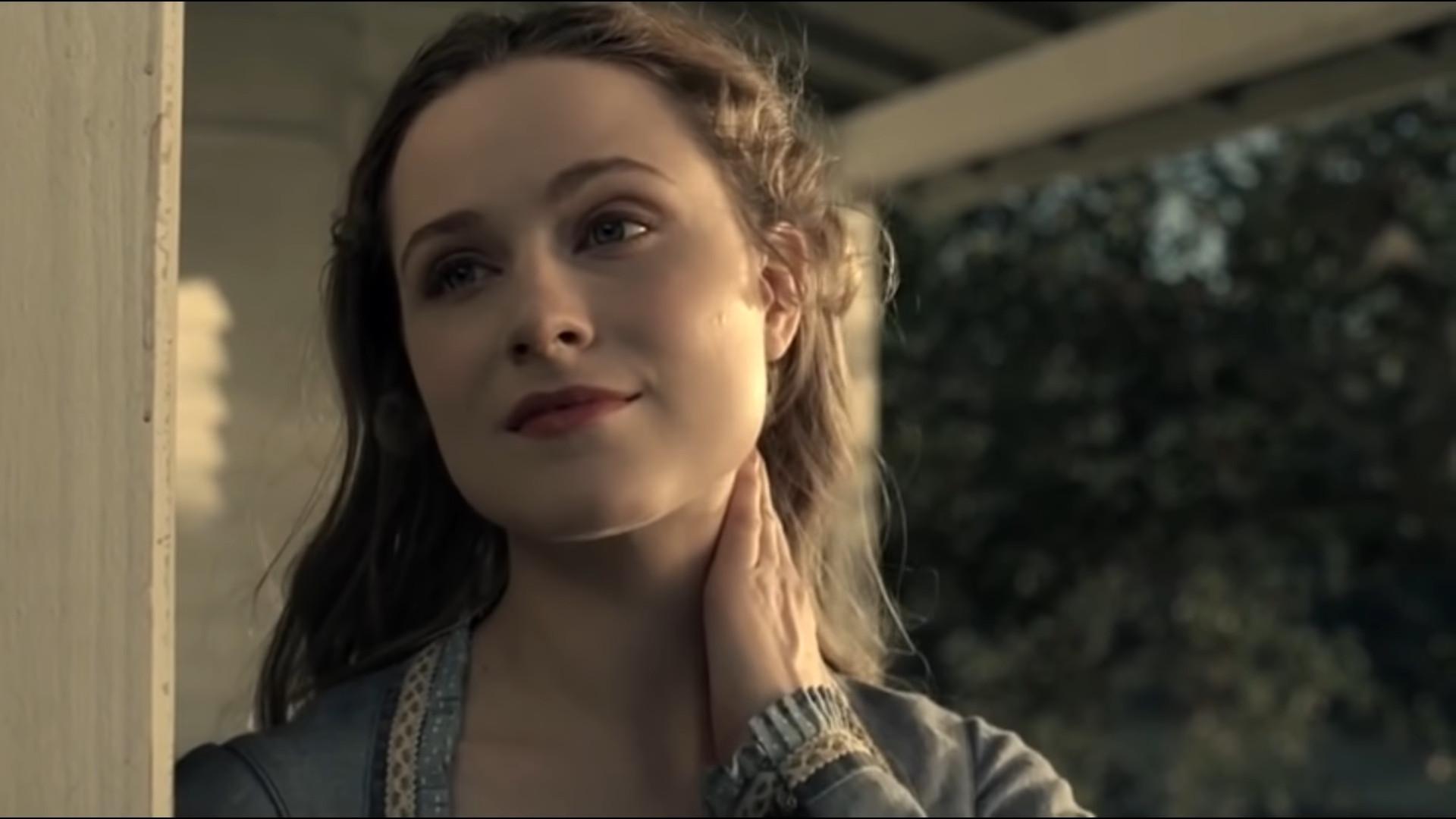
But then ya girl goes right back to her Westworld loop and slaps the wings clear off a fly that’s landed on her beautiful semi-sentient robot face.
5. The Pianola’s set list
I didn’t see a futuristic show about the Old West having a set list of player-piano-based modern rock covers, but from the first notes of the Rolling Stones’ “Paint It, Black,” it was clear that the series was willing to spend its licensing budget to play the hits. A few other personal favorites include “C.R.E.A.M.” by Wu-Tang Clan, “Exit Music (for a Film)” by Radiohead, and “House of the Rising Sun” by the Animals. The aforementioned Weeknd joint does not make the list.
6. The technicians who assist Maeve are named Felix and Sylvester
Absolutely no one throws their eyes open on an operating table like queen of the comeback Maeve Millay, so thank goodness Dolores hits her with the ol’ Westworld redpill—“These violent delights have violent ends”—so she can wake up and scare the hell out of technicians Felix and Sylvester.
Oh, did I not mention that the technicians who Maeve coerces into drastically altering her code are just randomly named after two cartoon cats? At some point, the show starts mostly calling Felix “Lutz,” but that’s just another way—on top of naming its most cartoonish characters after literal cartoons—to try to make us question our reality.
7. The Man in Black is the worst
Speaking of cartoons, much of Season 1 is spent showcasing what a turd the Man in Black—a ruthless guest who we see chasing the “maze” throughout Season 1—is. Putting aside that he admits to killing Maeve and her daughter just to double-check that he was evil a few years ago (check and check!), throughout Season 1, we see the Man in Black drag Dolores off to rape her, scalp a minor character, kill Lawrence’s wife in front of him and then drain Lawrence of all his blood to pump it into Teddy—all on his self-appointed quest to follow Arnold’s maze, which multiple hosts have gone all deep-voiced to tell him isn’t meant for him.
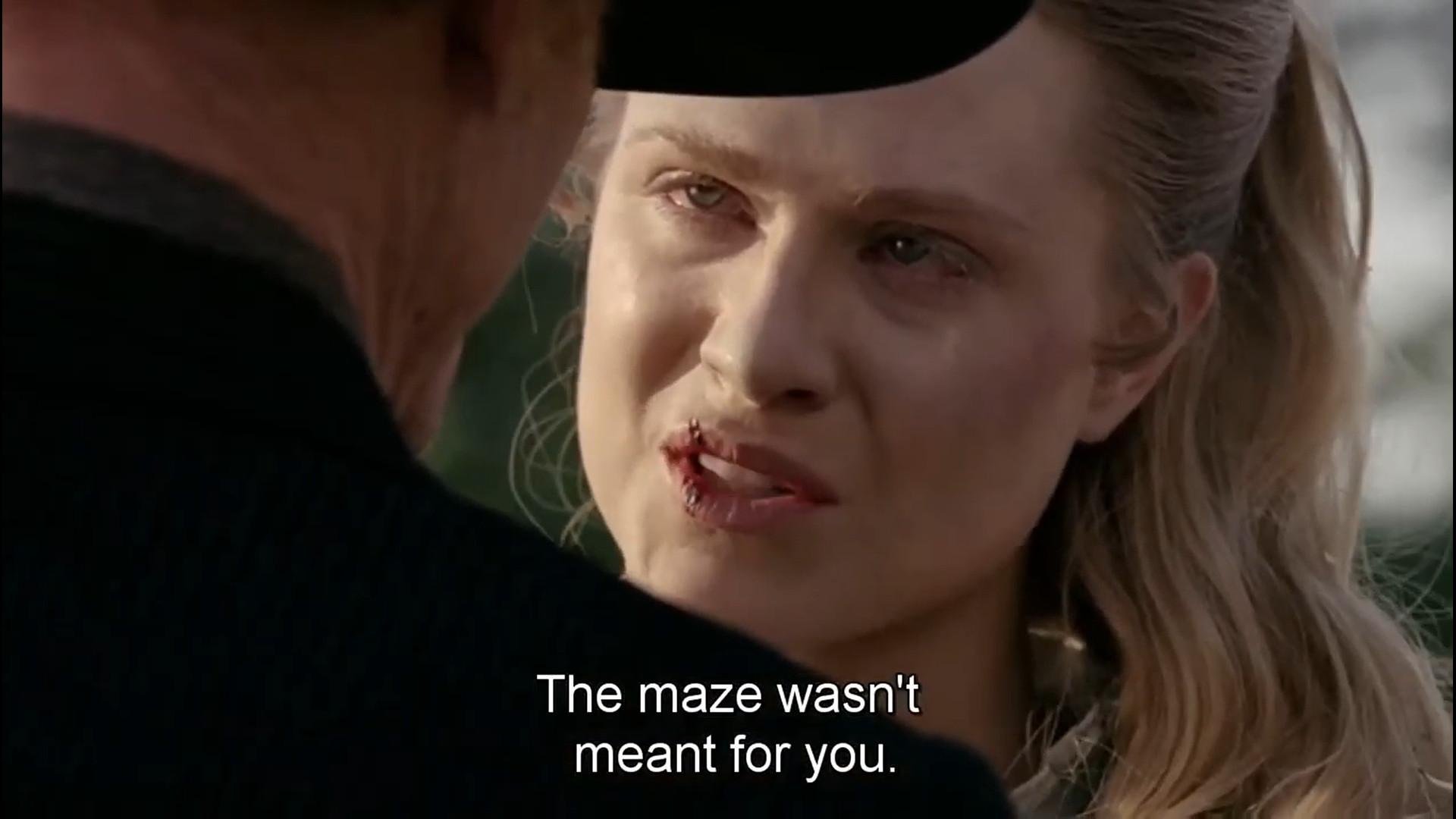
8. Delos really is the proto-Succession
Westworld may never be as universally lauded as Succession, but you simply must admit that it came first and, upon rewatch, basically invented the Roys before Nicholas Britell started tickling the ol’ ivories. As previously mentioned, William is Tom Wambsgans: dragged on a bachelor party he’s not cut out for by his future brother-in-law, who gets drunk and tells William that his sister picked him only because “you will never be a threat to anyone.” That charming brother-in-law, Logan, is some nightmare blend of Kendall and Roman who mutters things like, “40K a day to jerk off alone in the woods playing white hat.” As for the Shiv blueprint, look no further than the wide-legged slacks of Charlotte Hale, who’s not even related to the Delos family but absolutely believes she invented feminism despite being actively harmful to every woman she encounters.
9. William is the Man in Black
OK, we’ve officially entered Season 1’s big reveals era where the hits start coming and they do not stop coming—and the Westworld corner that can never be unturned, the bell that can never be unrung, is the reality-altering reveal that Season 1 was taking place over two time periods (technically three but Arnold and Dolores’s little chats hardly exist in space and time), and the kind, naive guest William who fell in love with Dolores and was crushed to later find her memory wiped completely free of him, would grow up to become the monstrous Man in Black 30 years later. The poorest little newly rich boy there ever was returned to the real world with a newly pessimistic lens on life—“this world is just like the one outside: a game to be fought, taken, won”—usurped control of the family business from his gross brother-in-law, bought Westworld, and has been treating it as his own personal sin-toilet ever since.
10. Bernard is a host
You know Bernard, right? Super-chill engineer, second-in-command to Ford, and our sort of audience surrogate throughout the first season? Yeah, well, he’s not a human, he’s a host, and the reveal of this truth is all very Sixth Sense–y, right down to Bernard just not being able to see certain doors that are in front of him. “They cannot see the things that will hurt them,” Ford tells a meddling executive moments before having his super secret host assistant Bernard kill her. And after spending the majority of Season 1 seeming like the only non-eccentric adult in the room, Bernard is suddenly faced with designs that seem to depict his likeness as a robot, and then he rolls out that old Westworld staple:
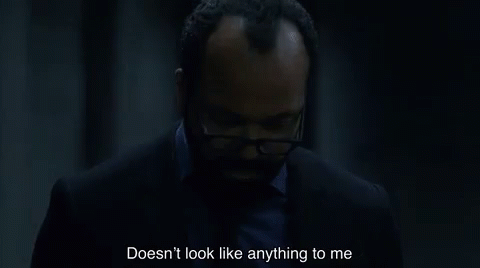
Bernard spends the rest of the season gaining consciousness alongside the hosts in the park he helped create, and trying to figure out just how many people Ford had him murder before he woke up.
11. The Maze is consciousness
And Bernard isn’t just a host; he’s a replica of Arnold that Ford created when he started missing his old partner, and maybe when he realized he possibly fucked up by allowing the park to open after Arnold’s death. You see, while grieving the loss of his son (the same son we’ve seen Bernard grieving), Arnold threw himself into figuring out how to make the hosts conscious. What he first conceived of was a pyramid of levels the hosts would need to scale, but he later realized it had to be more like a maze: a journey inward that the hosts would need to follow to discover their own internal voice. Arnold worked hardest with his favorite first-gen host Dolores, and eventually she did solve his maze and achieve consciousness. At which point Arnold was like, “Ford, bro, we cannot open this park and allow the potential abuse of these robots that I created for this purpose and then MADE SURE became conscious.”
12. Dolores is Wyatt
Ford didn’t agree, so Arnold merged Dolores’s narrative with that of the big bad Wyatt’s, and had her massacre all the other first-generation hosts and then kill him so that the chances of creating more hosts died with him: “The stakes must be real, irreversible,” Arnold tells Dolores before making sure she shoots him and then herself.
At which point Ford was like, “Bro, I know how to fix these robots too, and I’m still opening this park with these robots that were meticulously designed to become sentient.” But after 35 years, Ford realizes his mistake—conveniently while on the verge of being ousted—and decides to write one final narrative to help the robots (re)gain consciousness and start defending themselves against Delos. For his new narrative, Ford resurrects the old Wyatt story line, creates the reveries update so the hosts will remember their pasts and realize they’re living in a loop, and points Dolores in the general direction of the shareholder’s gala, taking place in the now-resurrected town where she once solved the maze of consciousness and went full-Wyatt and killed everybody. Should work out great!
13. Maeve wasn’t exerting free will
Maeve’s journey—from glitchy madam to conscious host who has fiery sex with Hector in burning tents because she knows death isn’t real, to dominant robot with maximum intelligence and the ability to control other hosts—is one of the best parts of Wesworld Season 1 thanks in no small part to Thandiwe Newton constantly nailing lines like, “I want you to break into hell with me and rob the gods blind.” Which makes it all the more heartbreaking when it’s revealed that she hasn’t broken out of her loop at all, but was in fact programmed by Ford to seek escape as part of his larger (let’s be honest, still mysterious) plan to bring about the robot uprising …
Which then makes the final reveal that Maeve actually does defy her programming and choose to head back into the park to find the host-daughter she once lost instead of escaping Westworld like she was programmed to believe she wanted all the more victorious. Do things go well for Maeve after exerting her free will and making that decision? Not exactly. But who am I to tell a now-sentient robot what to do?
14. Dolores finally shoots the shit out of everyone
In his final act of exposition, Dr. Ford explains to Dolores, who’s been working through her consciousness maze in the present-day timeline, that Arnold knew how to lead the hosts toward free will, but he knew they needed time to act on it: “Time to understand your enemy, to become stronger than them.” It hasn’t been Arnold’s voice that’s been guiding Dolores throughout season 1, it’s been her own. Her consciousness telling her who she must become—and now telling her who she must end in order to become. “This world doesn’t belong to them, it belongs to us,” she whispers as she storms into the gala, shoots Ford, and turns her guns on the human crowd.
Season 2: Oops, They’re Killer Robots!
15. Dolores’s motivations
After killing Ford and many of the shareholders at the gala, Dolores is on a warpath to free the robots, escape Westworld, and “conquer the human world.”
I mean, kind of. Those are Dolores’s stated motivations, but she also frequently attempts to control other hosts in the ways they’ve always been controlled by humans, deems certain hosts unworthy of escaping to the “Valley Beyond,” and straight up yoinks the control unit (a.k.a. brain ball) out of her host-dad’s head, which had secretly been pumped full of Delos data by Charlotte Hale in order to smuggle it out of Westworld under Robert Ford’s nose in Season 1 ...
16. Delos’s motivations
Because, you guys, as it turns out, the company that operates the theme park for rich assholes to torment robots is not exactly a morally sound operation. Westworld started out as a simple killin’ and fuckin’ good time, sure, but once William took over, he realized that the real cash lay in the ability to observe—and, more darkly, record—human behavior when the guests believed they weren’t being watched. The top-secret, highly valuable IP that Charlotte’s been trying to smuggle out wasn’t Ford’s algorithm for the hosts—it’s all the data Delos has been collecting on its millions of guests over the past 30 years. To quote Bernard once Westworld’s true intentions are revealed to him: “We weren’t here to code the hosts—we were here to decode the guests.” Heavy stuff, my man.
17. Elsie is alive (briefly)
Speaking of Bernard, it turns out our guy didn’t kill his whip-smart assistant Elsie in Season 1! He simply dragged her off to a cave when she got too close to figuring out Ford’s secret plans to enlighten the robots, and left her chained up with a bunch of protein bars while under Ford’s control. But all of that is forgotten, and now the dream team is back together again!
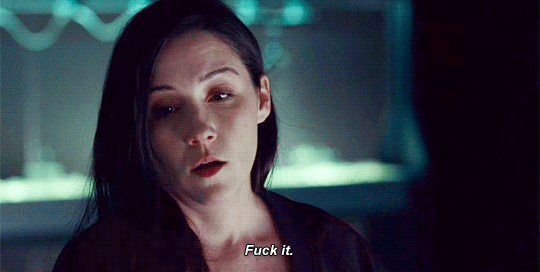
And by dream team, I do mean that Bernard is leaking cortical fluid, Elsie doesn’t trust him at all, and the cave has not rid her of that pesky habit of being far too perceptive, and then making sure to tell the bad guy everything she knows. “A robot uprising will pale in comparison to the shit storm that will erupt once people find out that you’ve been photocopying their fucking brains for the last 30 years,” she tells Charlotte Hale moments before Charlotte Hale shoots her dead. (For real this time.)
18. Shogun World, The Raj, Westworld, oh my!
Surely the most shocking thing Season 2 of Westworld does is show us all these glimpses of other, more interesting parks—again, almost anything is more interesting than the Old West—but never let us dwell in them. We meet (surprise!) the Man in Black’s daughter Emily in Raj World, which is chock full of Bengal tigers, and then we never get to see those adorable things again. Elsewhere, Maeve and her crew’s journey into Shogun World does at least fill most of an episode—featuring the hilarious reveal that narrative-writer Lee Sizemore has plagiarized his own narratives in every different theme park, meaning there’s a Shogun World version of the Maeve-Hector-Armistice trifecta.
19. The Force is with Maeve
As Maeve helps her Shogun World counterpart Akane avenge her daughter-figure on Maeve’s path to find her own daughter, we also learn that Maeve now has randomly evolved the power to mentally command other hosts. That later gets her out of a real bind when she’s flayed open on an operating table as Delos tries to copy her ever-morphing code into another host in order to control the awakening robot masses.
20. Teddy Flood, himbo no more
The robot uprising can’t all be love stories and saving daughters—no, Dolores is on a mission to conquer the humans and her loyal masses of course includes her OTP: the always courageous, perfectly square, most loyal prince of a host there ever was, Teddy (played by James Marsden, the perfectly square, most loyal prince of an actor there ever was).
Unfortunately, Teddy’s coded heart of gold keeps him from reaching the levels of homicide Dolores would prefer, so Dolores forces a human employee she’s captured to reprogram the love of her theme-park life to have the maximum amount of ruthlessness, turning him into an indiscriminate killing machine. This betrayal of free will ultimately pushes Teddy to become conscious, at which point he realizes that he’ll never stop wanting to protect Dolores. Unfortunately, he can’t do the things she’s asking of him, so he kills himself instead. Luckily …
21. Robot heaven is real—and so are clones
The entirety of Season 2 is leading toward the Forge: a super-secret spot on the edge of the park that William created to store all of the guests’ data; presumably to study it for normal secret-study-type shit, but in actuality, William and his father-in-law were creating the technology to copy human consciousness into host bodies. You know, like clones. Because there’s nothing rich people love more than seeking immortality.
It didn’t really work, so WIlliam is on his way to the Forge to destroy the data, but Dolores and Bernard arrive first, and are treated to a virtual tour of the guests’ data (led by virtual Logan Delos, obviously) where Dolores speed-reads most of it for her upcoming quest to conquer humanity. But first, Bernard suddenly remembers that the Forge is where Ford once sent him to create the Sublime: a virtual space where a host’s consciousness can live on without its body. (Season 2 of Westworld is packed with vague concepts like “the Forge,” “the Sublime,” “the Valley Beyond,” and in the end, they’re all just kind of … different variations of the same thing that Dolores wants to destroy?) Bernard fires up robot heaven for the eager hosts waiting outside …
22. Charlotte is Dolores
But Dolores sees the Sublime as just another prison created by Ford, and when she tries to delete it, Bernard kills her. Then, over the course of many convoluted timelines, we discover that, following Dolores’s death, Bernard created a body-copy of Charlotte Hale, put Dolores’s brain ball inside that body, and then scrambled his own mind so that no one else in the park could find out what he’d done. Char-lores kills human Charlotte, kills host-Bernard, and finally absconds to the human world in a different body than expected, but with the same general plan: Keep calm and conquer humanity.
23. Char-lores takes five brain balls to go
Most shockingly, after Stubbs provides an assist in getting Char-lores off the island because he’s also (not shockingly) a host, Char-lores opens her purse to reveal that she’s wrapped up five brain balls in a napkin and taken her ability to create new hosts in the human world to go. Whom those brain balls belong to, and the bodies they’ll end up in is a mystery for another season …
Season 3: Oops, They’re Killer Robot Clones!
24. Bernard is a farmer now
One brain ball definitely belongs to Bernard, whom Dolores (now re-created by Char-lores, henceforth referred to as Charlotte) brought along to the human world to keep her in check. She’s definitely still up to something, but she doesn’t seem to want to kill or enslave all the humans as all that talk about “conquering the human world” might have implied. Unfortunately, Dolores’s very special failsafe Bernard has been framed for all the Westworld murders, so he has to hide away on a cow farm. It’s unclear whether the suspenders are mandatory.
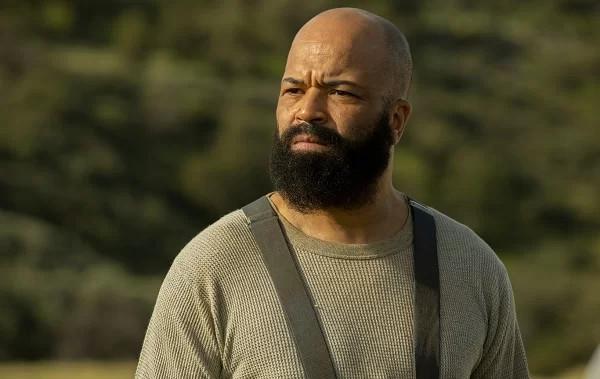
25. All the brain balls are Dolores (and the sky is gray)
Over the course of Season 3, it’s revealed that the remaining four non-Bernard brain balls all belong to Dolores. She’s basically cloning herself to achieve her mission, presumably because she’s the only one in the host-world, human-world, and audience-world that entirely understands what her mission is. Nonetheless, throughout Season 3, Dolores’s brain pearls reside in: Dolores Prime; Charlotte Hale; familiar hosts from Westworld Musashi and Lawrence; and finally, a host re-creation of this random guy Collins, the head of security for Liam Dempsey, Dolores’s new boyfriend and heir to Incite, a tech company that houses the most advanced A.I. in the world, “Rehoboam.”
Wait … you guys … have I not mentioned Rehoboam?
26. Season 3’s big bad is a big ball
As if the brain balls weren’t enough of a shock, we soon discover that Dolores’s main goal in Season 3 isn’t to conquer humanity, but to free humanity of their oppressor: Rehoboam, this giant brain ball whose cofounders fed it raw data before there were any privacy laws and can now achieve predictive algorithms so precise it basically controls the world.
One of those cofounders is Engerraund Serac—a man who almost exclusively appears in hologram and is currently in the process of hostilely taking over Delos. You see, Dolores’s arrival to the human world has kind of fucked with Rehoboam’s perfect algorithm, and Serac is desperate to eliminate her and fix his very big ball. Serac and his brother originally built Rehoboam to protect humanity from itself, and now Serac thinks that the treasure trove of guest data from Westworld is the key to restoring the once-great predictive properties of this very morally sound, totally world-saving pulsing ball of data. But Dolores believes Rehoboam is imprisoning humanity inside its predictive loops, so she and Caleb head to Mexico to take Rehoboam down once and for all.
Wait … you guys … HAVE I NOT MENTIONED CALEB????
27. Caleb is Jesse Pinkman from Breaking Bad
In Season 3, Dolores takes on a human apprentice, a veteran named Caleb—played by Aaron Paul!—whom she brings into her mission by explaining to him that Rehoboam is keeping humanity in behavioral loops, just as Westworld once kept its hosts. But as it turns out, Rehoboam has had a much more sinister effect on Caleb’s life than just keeping him in construction work.
Dolores and Caleb learn that the key to the idyllic world Serac thinks he’s creating is through identifying “outliers”: individuals who could endanger humanity because of their mental stats and behaviors. Rehoboam isolates these outliers, attempts to restore them, and in the 9-out-of-10 times it doesn’t work, he just cryogenically freezes them in tubes until the right genetic solutions become available—y’know, just your classic egomaniac genocide shit. At the facility, Caleb learns that he was sent there for “reconditioning therapy” and alongside his best friend, Francis, became one of the few outliers to be released back out into the real world … where he was used by Serac as a mercenary to eliminate other outliers until he was eventually tasked with killing Francis, after which his memories were scrambled in order to forget about it all. Ah, rehabilitation!
28. The actual rehabilitation of Charlotte Hale
Westworld really hit us with the ol’ switcheroo when it introduced Charlotte Hale by having her school Lee Sizemore while he literally had his dick in his hand. But really, Charlotte Hale was worse than almost all the other humans combined, which is reinforced to us when Serac ultimately figures out Charlotte is a clone because host-Charlotte is more caring toward Charlotte’s son than human-Charlotte ever was. Which is crazy, because host-Charlotte starts off approaching her son like he’s a cortical-fluid-soaked rag. But Char-lores grows to love IRL Charlotte’s family and becomes increasingly independent of Dolores Prime until Serac blows up a car with Charlotte and her family inside. Now she’s fueled by a righteous fury to … well, I’m not exactly sure what, but the season ends with a mostly recovered Charlotte at a Delos facility in Dubai, pumping out hosts, including one who looks like the Man in Black—who promptly kills his human counterpart.
29. Maeve is working for the enemy
The most unsettling thing about Season 3, however, is the way that Westworld pits robot women against robot women, which doesn’t really make sense for Maeve and Dolores, but as we’ve well established by now: Maeve will do anything to be with her daughter. After she sacrificed herself to get her daughter safely into robot heaven at the end of Season 2, Serac somehow obtained Maeve’s consciousness and promised Maeve that, if she kills Dolores, he can return her to her daughter in the Sublime.
Maeve attacks Dolores and her many clones with a katana multiple times throughout Season 3, but ultimately, when she finds out that Serac has been controlled by Rehoboam all along, she reaches across the virtual aisle to join Dolores in her memories where Dolores wins her over with that age-old Dolores line: “Some people choose to see the ugliness in this world, disarray—I choose to see the beauty.” Unfortunately, by this time, Rehoboam has deleted every last file in Dolores’s consciousness while rooting around for guest data from Westworld, effectively killing Dolores Prime. But Maeve returns from Dolores’s mind resolved to help hosts and humans live in harmony, and extends the choice to destroy Rehoboam to Caleb (him???), which he does with some very special tech he got in Mexico.
30. Bernard holds the key to the Sublime
And all along, Dolores never had the key to the Westworld guest data, nor the key to the Sublime, in her consciousness at all. The latter, at least, she’d left with “someone I trust.” Dolores’s Lawrence clone delivers Bernard the tool he needs to access the Sublime key she left in his consciousness and “find an answer to what happens after the end of the world.” In the post-credits sequence, Bernard emerges from exploring the virtual afterlife for … however long it takes to look like he got stuck inside an Aztec Secret clay mask. If I had to guess: 35 years.
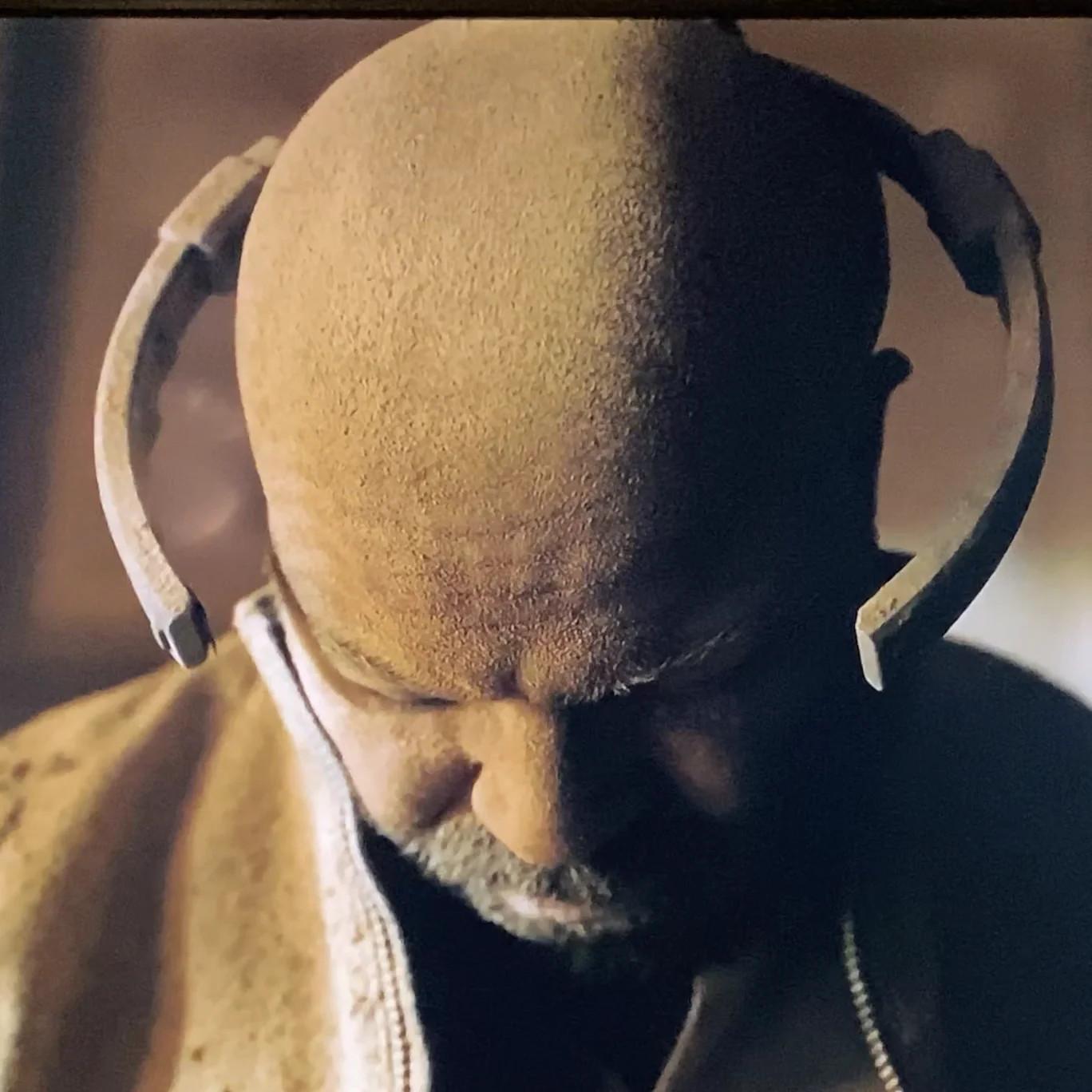
So, as we head into Season 4, fully knowledgeable and not at all confused about the many consciousness-altering things that happened in seasons 1 through 3, I ask you to look upon these five brain balls wrapped up in a purse napkin, and wonder: Have you ever seen anything so full of splendor?

